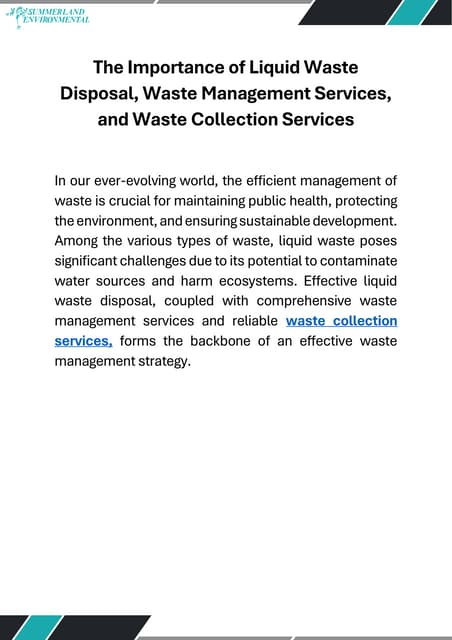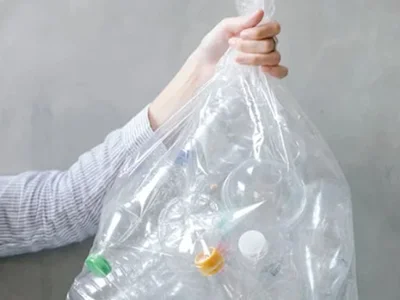The smart Trick of Reclaim Waste That Nobody is Discussing
The smart Trick of Reclaim Waste That Nobody is Discussing
Blog Article
The 8-Second Trick For Reclaim Waste
Table of ContentsNot known Facts About Reclaim WasteNot known Facts About Reclaim WasteReclaim Waste for BeginnersGetting My Reclaim Waste To WorkGetting The Reclaim Waste To Work
Residential sewer waste refers to the waste and products from a household septic storage tank. The correct monitoring and disposal of domestic sewer waste require fluid waste to be moved to a sewer therapy plant where the appropriate techniques and tools are applied to purify and dispose of waste.
Business waste commonly includes possible dangers, such as combustible products or a mix of fluid and solid waste items, and requires an advanced and thorough disposal process. The disposal of industrial waste commonly includes the purification of waste prior to transport to make sure risk-free and appropriate disposal. Industrial waste is produced from byproducts and overflow of industrial procedures and production.
This kind of waste can not use the exact same sewer monitoring transportation or processes as septic or business liquids. The industrial waste management procedure needs the inspection and screening of fluid waste prior to it goes through the disposal procedure (liquid waste removal). Drainage waste is the liquid waste that originates from runoff and excess stormwater in highly populated areas or cities
Drainage waste can create contamination and flooding if not managed effectively. Guaranteeing correct waste administration can avoid disasters and decrease ecological harm.
An Unbiased View of Reclaim Waste
Get in touch with PROS Services today to learn more about our waste management and disposal services and the correct ways to look after the liquid waste you create.
(https://www.domestika.org/en/reclaimwaste1)This so-called 'wastewater' is not only an essential resource but, after therapy, will be launched to our land, waterways or the sea. Utilized water from commodes, showers, baths, cooking area sinks, laundries and commercial processes is recognized as wastewater.

water used to cool down machinery or tidy plant and equipment). Stormwater, a kind of wastewater, is drainage that moves from agricultural and metropolitan locations such as roofing systems, parks, yards, roads, paths and rain gutters right into stormwater drains, after rainfall. Stormwater moves neglected directly to neighborhood creeks or rivers, at some point reaching the sea.
Reclaim Waste Things To Know Before You Buy
In Queensland, many wastewater is dealt with at sewer therapy plants. Wastewater is moved from domestic or industrial sites with a system of drains and pump stations, referred to as sewerage reticulation, to a sewage treatment plant. City governments build, maintain and run most sewage therapy plants. Operators are licensed under the Environmental Management Act 1994 to release treated wastewater at an acceptable environmental standard into rivers.
The Division of Natural Resources advises regional governments concerning managing, operating and preserving sewerage systems and therapy plants. In unsewered areas, city governments might need householders to install specific or family sewer therapy systems to treat domestic wastewater from toilets, cooking areas, washrooms and visit our website laundries. The Department of Natural Resources authorizes making use of household systems when they are proven to be reliable.
The majority of stormwater receives no treatment. In some brand-new class, treatment of some stormwater to eliminate litter, sand and gravel has begun using gross contaminant traps. Wastewater therapy happens in four stages: Removes strong issue. Bigger solids, such as plastics and various other objects mistakenly released to drains, are removed when wastewater is travelled through screens.
Wastewater then flows right into large containers where solids clear up and are eliminated as sludge. Oil and residue are skimmed from the surface. Utilizes little living organisms understands as micro-organisms to break down and get rid of staying liquified wastes and fine fragments. Micro-organisms and wastes are integrated in the sludge. Gets rid of nitrogen and phosphorus nutrients that might cause algal blooms in our waterways and threaten marine life.
Everything about Reclaim Waste
Nutrient elimination is not readily available at all sewer treatment plants since it needs expensive specialized tools. Clear fluid effluent created after treatment may still have disease-causing micro-organisms - liquid waste disposal.

A lot of wastewater streams right into the sewerage system. Under the Act, neighborhood federal governments provide approvals and permits for eco appropriate tasks (Ages) entailing wastewater releases that could have a regional effect.
Getting The Reclaim Waste To Work
Surveillance provides accurate information regarding water quality and can validate that permit problems are being fulfilled. The info acquired with surveillance gives the basis for making water quality decisions.
Report this page